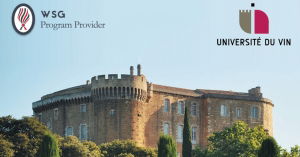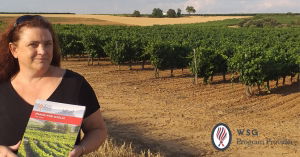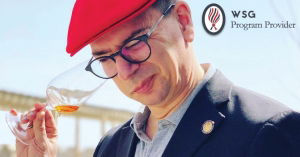BLOG
wine education
Chris Martin MW joins the Wine Scholar Guild as our new Director of Education. Simon J Woolf spoke to him about his background and what he’ll be bringing to the role.
There’s an assumption in the wine world that if you’re knowledgeable in your subject area, ergo you can teach. Chris Martin MW wants to challenge that idea. Unusually for the sector, he started out in the world of education and latterly cross-trained in wine.
Meet Alessandra Esteves MAES, DipWSET, FWS from Florida Wine Academy, a new Wine Scholar Guild approved program provider in Miami, Florida.
Her first French Wine Scholar session started August 7th with another one scheduled to begin November 28th 2018. Learn more HERE.
Give us a bit of background on your history in wine and your wine school, the Florida Wine Academy.
Meet Géraldine Gossot, Director of l'Université du Vin in Suze la Rousse, new French Wine Scholar® program provider in France!
The first FWS session at l'Université du Vin is scheduled to begin December 2nd 2019, more information and registration HERE
L'Université du Vin is one of the oldest wine education centers in France... Can you tell us more about the University, its origin, mission and importance in wine education in France?
Meet Jeni Wilson, founder of Vintage Class in Aranda de Duero, first wine school to launch the French Wine Scholar® in Spain!
Their first FWS is scheduled to begin January 22th 2020, more information and registration HERE.
Vintage Class will also offer the Spanish Wine Scholar® in 2020!
Could you give us a bit of background on your personal and/or professional history in wine and what made you decide to move into wine education?
Meet Jörg Philipp, founder of Degustar in Stuttgart, first wine school to offer our brand new Spanish Wine Scholar® program in Germany!
Your company, Degustar, is based in Stuttgart, Germany but you also work in Shanghai, China. Can you please summarize all the activities offered by Degustar in Germany and in China?
Meet Julien Boulard aka "Zhulian", one of China's most well-known French wine professionals with over 40,000 followers on Weibo.
We are truly thrilled to welcome Julien, a Frenchmen of passion and talent, to bring the French Wine Scholar study & certification program to Nanning and Guangzhou. The first sessions will be announced shortly on Zhulian Wines' Weibo page.
Q1. Julien, give us a brief background on your history in wine and your wine school
After completing a Master in International Affairs (which I took because they offered intensive Chinese classes), my first job was for a wine importer located in a small Chinese city called Nanning. Well, small as in six million habitants…! The boss obviously offered me the job because I was French, and this particular feature could help bring some “authenticity” to his company. I wasn’t keen on being just a white face who could speak Chinese, so I decided that I had to study wine to add another string to my bow.
Massimiliano Guerra, IWS, FWS, Wine Enthusiast
We have our first ever perfect score on the Italian Wine Scholar exams!
Meet Paul Miles, educator at IWEG in Toronto, Canada.
School: IWEG Educator: Paul MilesLocation: Toronto
Paul Miles has worked in both the alcoholic and non-alcoholic beverage industry for over twenty years, specializing in brand strategy, channel and trade marketing, strategic account and distributor management, as well as business development. He is a graduate of Bristol University in England and has an MBA from the University of Edinburgh Business School in Scotland. He has also attended the Advanced Management Program at INSEAD in France. In 2014 he completed the WSET Level 4 Diploma in Wines and Spirits (Pass with Merit).
What made you decide to move into wine and, more specifically wine education?
Wine has always been an integral part of my life. I was born into a British family in the wine industry in the island of Madeira, Portugal...
Meet Eno Cultura, a new French Wine Scholar approved program provider in Brazil.
Their first FWS session is scheduled to begin October 18th in Sao Paulo. Learn more HERE.
Sharing their accumulated knowledge from over 25 years combined experience in the European wine industry, Paulo Brammer and Thiago Mendes founded EnoCultura wine school in 2013.
Q: Paulo, could you give us a bit of background on your personal and/or professional history in wine and your wine school, Eno Cultura?
Meet Reto Thörig and Juan Lo Bello from Wein-Werkstatt in Basel, first wine school to offer the French Wine Scholar® program in Switzerland!
The first FWS sessions at Wein-Werkstatt are scheduled to begin March and June 2020, more information and registration HERE
You state on your website that you help students to “experience wine – understand wine – promote wine”. Could you please introduce all the activities offered by Wein Werkstatt, your wine school in Basel?
An Interview With WSG's Newest French Wine Scholar Program Provider
We were recently lucky enough to add a fantastic Belgian school to our global French Wine Scholar Program Provider network. Sybille Troubleyn of Winewise in Antwerp tells us in this interview about how she got into wine, why she feels the French Wine Scholar program is a great addition to a WSET education provider's repertoire and how her school and the style of education they offer to wine students in Belgium is unique.
1) What type of education experience do you provide at your wine school that sets you apart?
We offer international wine qualifications and "Keep Up" sessions for wine professionals...
For the past 12 months, I have been hard at work bringing to life our new Producer Guide, the brainchild of our Founder and President, Julien Camus. As the project neared completion, I sat down with Julien to reflect on his motivations and vision for creating this groundbreaking initiative.
-Justin Martindale MW, WSG Membership & Community Manager
Following the WSG webinar series “Navigating a Career in Wine & Spirits”, it seems like an appropriate time to dive in a little deeper on some of the topics covered. Most would agree that there is no greater investment than the investment you make in yourself!
Congratulations to James Faulds, SWS, for passing the Spanish Wine Scholar exam with highest honors!
About James:
I am a wine enthusiast hoping to combine my love of cooking and wine. Seeking education in wine seemed a logical step to me as wine and food paired well can
If there’s one thing in the world I love, it’s judging. From driving, to elite sport, to other people’s parenting, if you’re looking for someone to cast ill-informed opinions out into the wind, I’m your man. So, when the opportunity arose to contribute to what is probably the world’s greatest wine judging competition, I signed myself up quicker than you can say ‘baby-lead weaning’. Thankfully this is one area where I’m at least a little more qualified to apply
Congratulations to Karen Rasmussen, FWS, for passing the French Wine Scholar exam with highest honors!
About Karen:
I am a wine professional with 10 years beverage industry experience in Denver, Colorado. In 2013, I caught the ‘wine bug’ working in a local wine shop and
Congratulations to Leslie Nguyen, IWS, for passing the Italian Wine Scholar exam with highest honors!
About Leslie:
After being a respiratory therapist for almost 20 years and feeling burnt out, I wanted to venture into a new career path. A
Wine Scholar Guild Education Director, Lisa M. Airey, CWE, FWS was knighted by the French government in a ceremony at the Embassy of France in Washington DC on March 28, 2018.
She was inducted as “chevalier” to the Ordre du Mérite Agricole for her contributions to French agriculture (namely, wine!).Sylvain Maestracci, Agriculture Counselor, officiated. It was his first knighting ceremony and hard to tell who was more touched as the medal got close to the lapel.Lisa was commended for the development of the French Wine Scholar Program which is now taught by over 50 program providers, in 53 cities, in 16 countries on 5 continents. It is also hosted as an online program in independent- and instructor-led formats.
Watch the Preview of the Spanish Wine Scholar Program, with Rick Fisher, Spanish Programs Director
Summary:
The vineyards of the Loire Valley follow the twists and turns of France's longest river, from the Atlantic coast to the Paris Basin. The region boasts the largest number of French white wine AOCs and also produces increasingly sought after reds. This webinar will explore the distinctive terroirs that define the grapes of each sub-region, look at the historical context and present winemaking trends that define




















